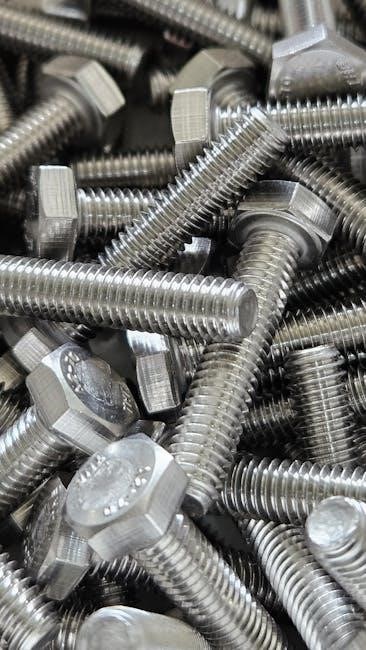stainless steel bolt tightening torque chart pdf
The introduction to stainless steel bolt tightening torque chart provides essential information on proper tightening procedures using a for secure assemblies always.
Importance of Proper Tightening Torque
The importance of proper tightening torque cannot be overstated, as it plays a crucial role in ensuring the structural integrity and safety of various assemblies and installations. A stainless steel bolt tightening torque chart pdf is a valuable resource that provides guidance on the appropriate torque values for different types of stainless steel bolts and fasteners. By using the correct tightening torque, individuals can prevent damage to the bolt or nut, as well as ensure that the assembled parts are properly secured. This is particularly important in applications where safety is a concern, such as in construction, automotive, and aerospace industries. Furthermore, proper tightening torque can also help to prevent corrosion and wear on the bolts and fasteners, which can lead to premature failure and costly repairs. Overall, the importance of proper tightening torque highlights the need for accurate and reliable torque values, which can be found in a stainless steel bolt tightening torque chart pdf. Using this chart can help to ensure that bolts and fasteners are tightened correctly, which is essential for maintaining the integrity and safety of various assemblies and installations.
Understanding the Concept of Tightening Torque
Understanding torque concepts is crucial for using a stainless steel bolt tightening torque chart pdf effectively always with proper techniques and tools available online.
Factors Affecting Tightening Torque
Several factors affect the tightening torque of stainless steel bolts, including the material and finish of the bolts and nuts, the presence of lubricants, and the condition of the threads.
The use of a stainless steel bolt tightening torque chart pdf can help account for these factors and ensure proper tightening.
A k factor of 0.2 is commonly used, assuming threads are burr-free and a good quality lubricant is used.
However, if the threads are damaged or the lubricant is of poor quality, the k factor can be higher, resulting in increased tightening torque.
The length of thread engagement also plays a role, as longer engagement lengths require higher tightening torques.
Additionally, the type of stainless steel used can affect the tightening torque, with different grades having different strength and corrosion resistance properties.
By considering these factors and using a stainless steel bolt tightening torque chart pdf, users can ensure that their bolts are tightened to the correct torque, preventing damage and ensuring a secure assembly.
This is especially important in applications where safety and reliability are critical.
Proper tightening torque is essential for preventing bolt failure and ensuring the integrity of the assembly.

A stainless steel bolt tightening torque chart pdf provides essential torque values for secure assemblies using stainless steel bolts and nuts always online.
How to Use the Chart
To use the stainless steel bolt tightening torque chart pdf, first identify the type of stainless steel bolt being used, including its grade and size. Then, locate the corresponding torque value on the chart, taking into account any factors that may affect the torque, such as lubrication or thread condition. It is also important to consider the material of the nut or threaded component, as this can impact the required torque. The chart should provide a range of torque values for different bolt sizes and grades, allowing users to select the appropriate value for their specific application. By following the guidelines outlined in the chart, users can ensure that their stainless steel bolts are tightened to the correct torque, providing a secure and reliable connection. The chart is typically presented in a table or graph format, making it easy to read and understand. Proper use of the chart requires attention to detail and an understanding of the factors that affect torque values.

Calculating Tightening Torque for Stainless Steel Bolts
Calculating torque involves using a formula with variables like bolt diameter and material, using a stainless steel bolt tightening torque chart pdf for reference always.
Example Calculations
To illustrate the calculation process, consider a stainless steel bolt with a diameter of 10mm and a length of 50mm, using a stainless steel bolt tightening torque chart pdf as a reference. The formula to calculate the tightening torque involves multiplying the bolt diameter by a factor, then multiplying by the coefficient of friction. For example, if the factor is 0.2 and the coefficient of friction is 0.1, the calculation would be 10mm x 0.2 x 0.1 = 0.2 Nm. This value can be used as a guideline for the tightening torque. Additionally, the chart provides a range of values for different bolt sizes and materials, allowing for more accurate calculations. By using the chart and following the calculation process, users can determine the optimal tightening torque for their specific application, ensuring a secure and reliable connection. The example calculations demonstrate the importance of using a stainless steel bolt tightening torque chart pdf for accurate and reliable results.

Common Mistakes to Avoid When Tightening Stainless Steel Bolts
Incorrect torque and over-tightening are common mistakes when using a stainless steel bolt tightening torque chart pdf always.
Consequences of Incorrect Tightening Torque
The consequences of incorrect tightening torque can be severe, resulting in damage to the bolt, nut, or surrounding material. Using a stainless steel bolt tightening torque chart pdf is crucial to avoid such mistakes. When the torque is too low, the bolt may not be securely fastened, leading to loose connections and potential failures. On the other hand, excessive torque can cause the bolt to strip or break, leading to costly repairs and downtime. Furthermore, incorrect tightening torque can also lead to premature wear and tear of the bolt and surrounding material, reducing their lifespan and requiring frequent replacements. It is essential to follow the recommended torque values and guidelines provided in the stainless steel bolt tightening torque chart pdf to ensure safe and reliable assemblies. By doing so, users can minimize the risk of errors and ensure the integrity of their constructions. Proper tightening torque is vital for maintaining the structural integrity and safety of the assembly.

